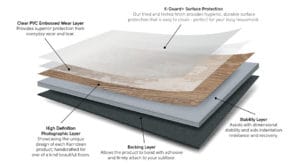Durable vinyl flooring options
By Autumn Sibo,
Before you start shopping for durable vinyl flooring options, there are some essential things you want to consider:
THICKNESS
You need to consider the protective wear layer, core, and backing to find the depth of a vinyl plank. For actual plank thickness, you are looking for measurements in mm. Lower-quality planks fall in the 4mm range, and higher-quality planks are 8mm or thicker. However, it makes a difference if it is glue-down or click-and-lock…
GLUE DOWN VS CLICK
Click vinyl utilizes a click-and-lock system comparable to laminate to keep the floor connected and secure. Glue-down vinyl uses adhesive to seal the vinyl to the subfloor. The overall thickness for a 4mm is usually for a click together; Karndean’s 30mil wear layer glue down products are 3mm thick and will hold up better than any click together at 5-1/2 to 6mm in overall thickness with a 20mil wear layer. So what is a wear layer, you ask?
WEAR LAYER
The wear layer rests between the printed design and the urethane finish. This layer is a critical determinant of how well your floors will hold up over time. The printed design will degrade if this wear layer breaks down. More reliable vinyl floors have wear layers that incorporate a shielding topcoat. This coating often includes additives like ceramic or other materials to enhance the hardness level of the planks.
The wear level on a vinyl plank is measured in mil (one-thousandth of an inch), not to be confused with a millimeter. The thicker the wear layer is, the higher resistance it will have to dents and scratches. In other words, more dependable quality flooring tends to have the highest wear layers; however, it is more expensive. You will want vinyl planks with a wear layer of at least 12 mil for regular residential use. If you have pets or an energetic family, you would be better off buying 20 mil or higher.
CORE
Some luxury vinyl planks have a dense wood-plastic composite core called WPC (Wood Plastic or Polymer Composite). WPC consists of wood flour blended with thermoplastic and calcium carbonates. Therefore, this type of flooring is phthalate-free and safer for your household.
Planks with a rigid center are more durable and have better stability. In addition, solid cores are water-resistant and hide minor blemishes in the subflooring, making them a more desirable choice when installed over an existing floor.
BOTTOM
The bottom, or backing, may consist of corking or other soundproofing material which provides underfoot cushioning. The thicker it is, the more pleasant it will be to stand and walk on. Some planks have attached underlayment for better warmth retention and sound reduction. With this in mind, underlayment is very helpful in second-floor applications. Not all vinyl planks include an underlayment backing. However, you can add an underlayment during installation.
When shopping for durable vinyl options, there is a lot to consider – thickness, wear level, core construction, underlayment, glue down or click and lock. Luxury vinyl flooring with added underlayment is warmer and quieter. If durability is your main concern, look for vinyl planks with the highest wear layers. Depending on your subfloor, click-and-lock vinyl might work better than glue-down or vice versa. Speak with one of our knowledgeable Flooring Consultants – they are waiting to help you find just the right vinyl flooring for your home.

